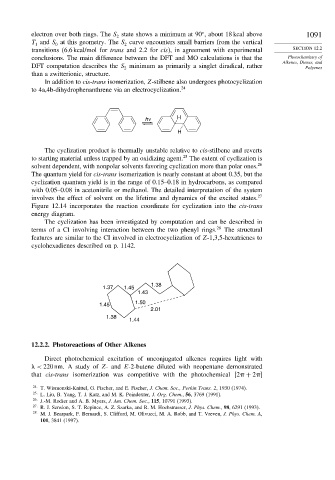Page 1106 - Advanced Organic Chemistry Part A - Structure and Mechanisms, 5th ed (2007) - Carey _ Sundberg
P. 1106
electron over both rings. The S state shows a minimum at 90 , about 18 kcal above 1091
2
T and S at this geometry. The S curve encounters small barriers from the vertical
1 0 2
transitions (6.6 kcal/mol for trans and 2.2 for cis), in agreement with experimental SECTION 12.2
conclusions. The main difference between the DFT and MO calculations is that the Photochemistry of
Alkenes, Dienes, and
DFT computation describes the S minimum as primarily a singlet diradical, rather Polyenes
2
than a zwitterionic, structure.
In addition to cis-trans isomerization, Z-stilbene also undergoes photocyclization
to 4a,4b-dihydrophenanthrene via an electrocyclization. 24
h ν H
H
The cyclization product is thermally unstable relative to cis-stilbene and reverts
25
to starting material unless trapped by an oxidizing agent. The extent of cyclization is
solvent dependent, with nonpolar solvents favoring cyclization more than polar ones. 26
The quantum yield for cis-trans isomerization is nearly constant at about 0.35, but the
cyclization quantum yield is in the range of 0.15–0.18 in hydrocarbons, as compared
with 0.05–0.08 in acetonitrile or methanol. The detailed interpretation of the system
involves the effect of solvent on the lifetime and dynamics of the excited states. 27
Figure 12.14 incorporates the reaction coordinate for cyclization into the cis-trans
energy diagram.
The cyclization has been investigated by computation and can be described in
terms of a CI involving interaction between the two phenyl rings. 28 The structural
features are similar to the CI involved in electrocyclization of Z-1,3,5-hexatrienes to
cyclohexadienes described on p. 1142.
1.38
1.37 1.45
1.43
1.50
1.45
2.01
1.38
1.44
12.2.2. Photoreactions of Other Alkenes
Direct photochemical excitation of unconjugated alkenes requires light with
< 220nm. A study of Z- and E-2-butene diluted with neopentane demonstrated
that cis-trans isomerization was competitive with the photochemical [2 + 2
24 T. Wismonski-Knittel, G. Fischer, and E. Fischer, J. Chem. Soc., Perkin Trans. 2, 1930 (1974).
25
L. Liu, B. Yang, T. J. Katz, and M. K. Poindexter, J. Org. Chem., 56, 3769 (1991).
26
J.-M. Rodier and A. B. Myers, J. Am. Chem. Soc., 115, 10791 (1993).
27 R. J. Sension, S. T. Repinec, A. Z. Szarka, and R. M. Hochstrasser, J. Phys. Chem., 98, 6291 (1993).
28
M. J. Bearpark, F. Bernardi, S. Clifford, M. Olivucci, M. A. Robb, and T. Vreven, J. Phys. Chem. A,
101, 3841 (1997).

